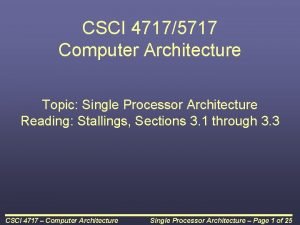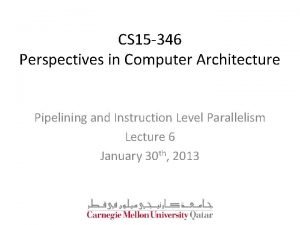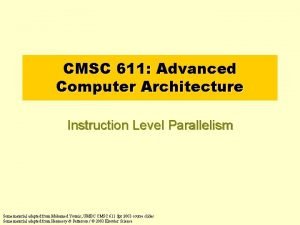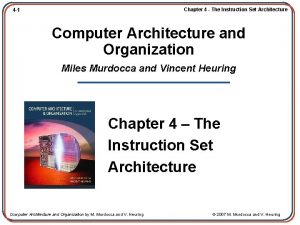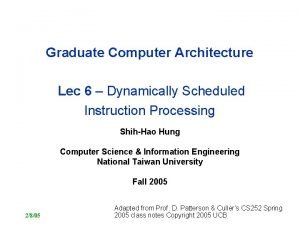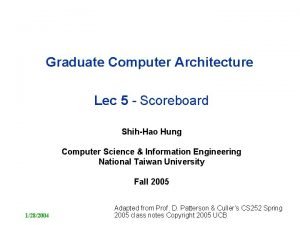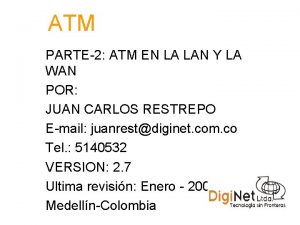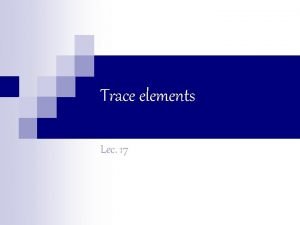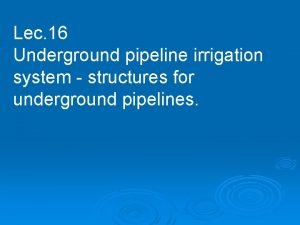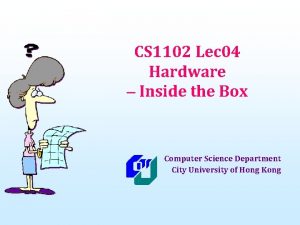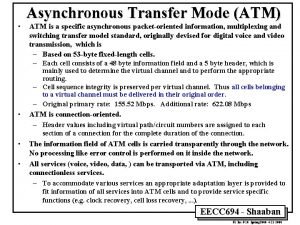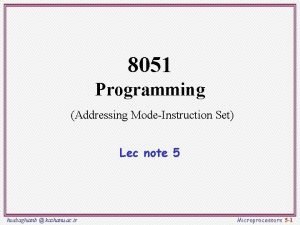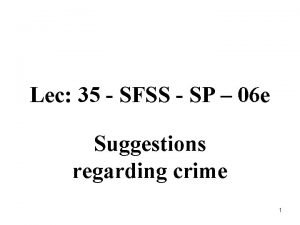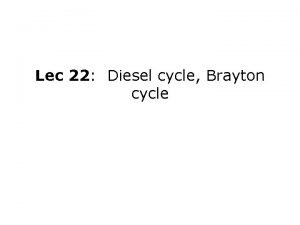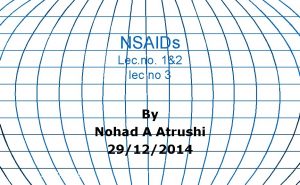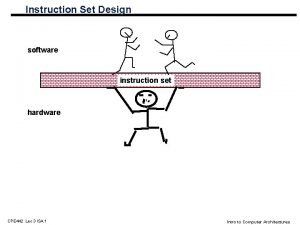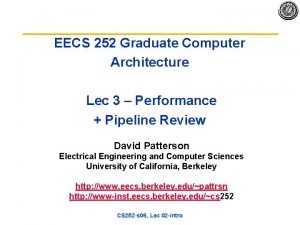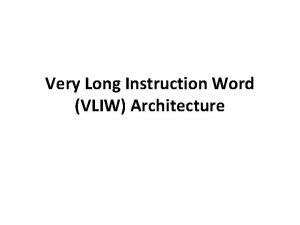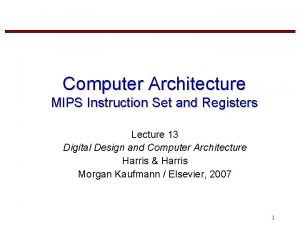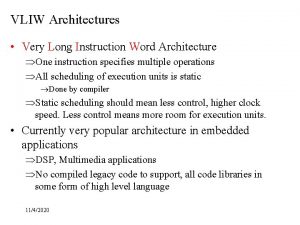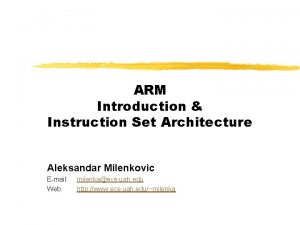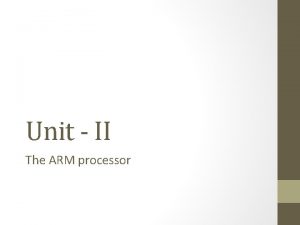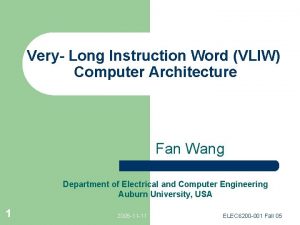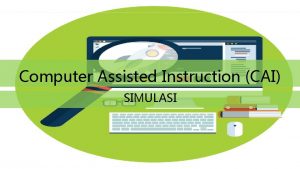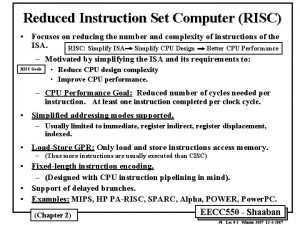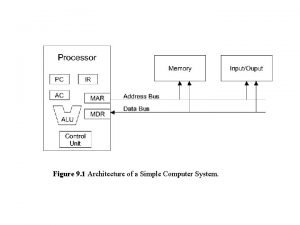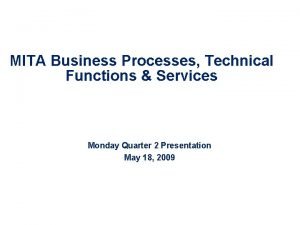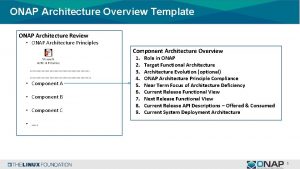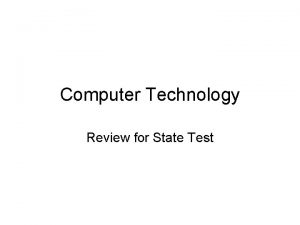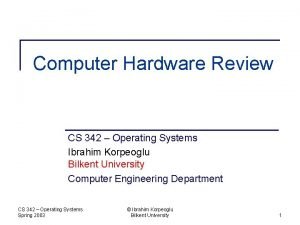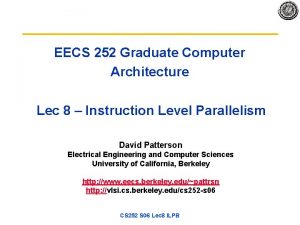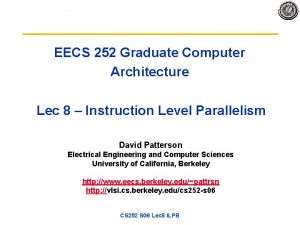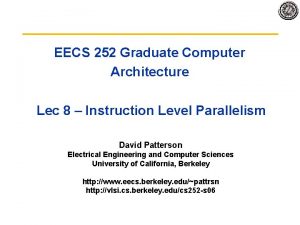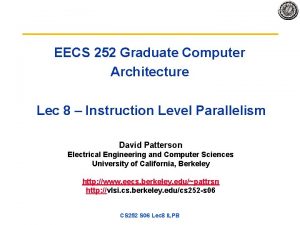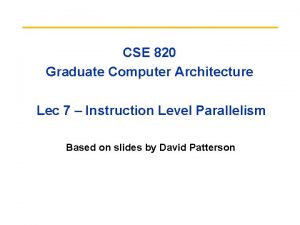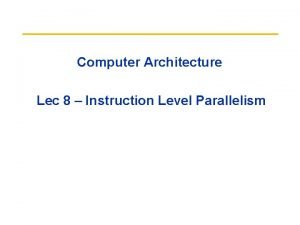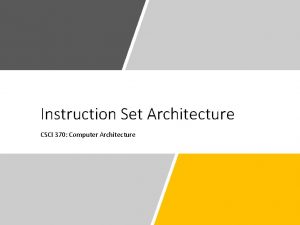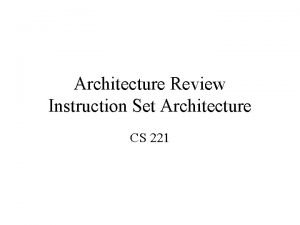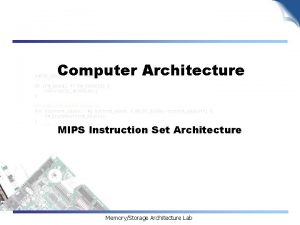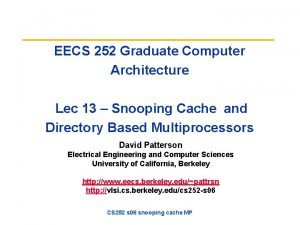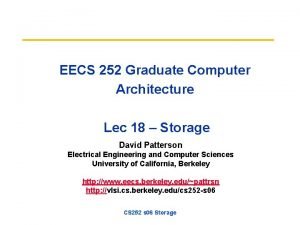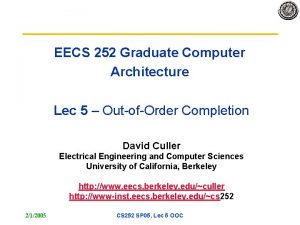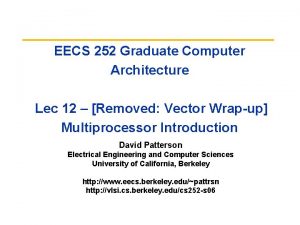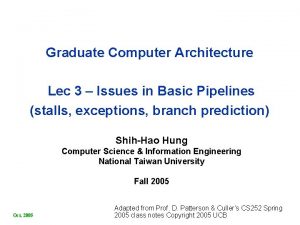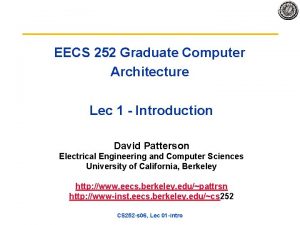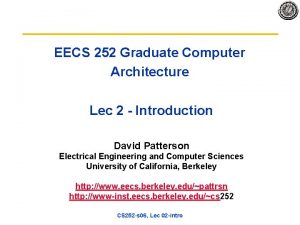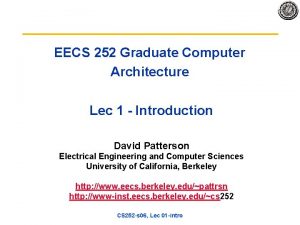Graduate Computer Architecture Lec 2 Review of Instruction


















![Inst. Set Processor Controller IR <= mem[PC]; PC <= PC + 4 JSR A Inst. Set Processor Controller IR <= mem[PC]; PC <= PC + 4 JSR A](https://slidetodoc.com/presentation_image_h2/b714fc2d6f488088b5405bf9fdcb95ee/image-19.jpg)

























































- Slides: 76

Graduate Computer Architecture Lec 2 Review of Instruction Sets, Pipelines, and Caches Shih Hao Hung Computer Science & Information Engineering National Taiwan University Fall 2005 Oct. 2005 Adapted from Prof. D. Patterson’s class notes Copyright 1998, 2000 UCB 1

Review, #1 • Technology is changing rapidly: Capacity Speed Logic 2 x in 3 years DRAM 4 x in 3 years 2 x in 10 years Disk 4 x in 3 years 2 x in 10 years Processor ( n. a. ) 2 x in 1. 5 years • What was true five years ago is not necessarily true now. • Execution time is the REAL measure of computer performance! – Not clock rate, not CPI • “X is n times faster than Y” means: Oct. 2005 2

Amdahl’s Law Best you could ever hope to do: Oct. 2005 3

Today: Quick review of everything you should have learned Oct. 2005 4

CPI Computer Performance inst count CPU time = Seconds = Instructions x Program Cycles Cycle time x Seconds Instruction Cycle Inst Count CPI Clock Rate Program X Compiler X (X) Inst. Set. X X Organization Technology Oct. 2005 X X X 5

Cycles Per Instruction (Throughput) “Average Cycles per Instruction” CPI = (CPU Time * Clock Rate) / Instruction Count = Cycles / Instruction Count “Instruction Frequency” Oct. 2005 6

Example: Calculating CPI bottom up Run benchmark and collect workload characterization (simulate, machine counters, or sampling) Base Machine (Reg / Reg) Op ALU Load Store Branch Freq 50% 20% 10% 20% Cycles 1 2 2 2 CPI(i). 5. 4. 2. 4 1. 5 (% Time) (33%) (27%) (13%) (27%) Typical Mix of instruction types in program Design guideline: Make the common case fast MIPS 1% rule: only consider adding an instruction of it is shown to add 1% performance improvement on reasonable benchmarks. Oct. 2005 7

Example: Branch Stall Impact • Assume CPI = 1. 0 ignoring branches (ideal) • Assume solution was stalling for 3 cycles • If 30% branch, Stall 3 cycles on 30% Op Freq Other 70% Branch 30% Cycles CPI(i) 1. 7 4 1. 2 (% Time) (37%) (63%) new CPI = 1. 9 • New machine is 1/1. 9 = 0. 52 times faster (i. e. slow!) Oct. 2005 8

SPEC: System Performance Evaluation Cooperative • First Round 1989 – 10 programs yielding a single number (“SPECmarks”) • Second Round 1992 – SPECInt 92 (6 integer programs) and SPECfp 92 (14 floating point programs) » Compiler Flags unlimited. March 93 of DEC 4000 Model 610: spice: unix. c: /def=(sysv, has_bcopy, ”bcopy(a, b, c)= memcpy(b, a, c)” wave 5: /ali=(all, dcom=nat)/ag=a/ur=4/ur=200 nasa 7: /norecu/ag=a/ur=4/ur 2=200/lc=blas • Third Round 1995 – new set of programs: SPECint 95 (8 integer programs) and SPECfp 95 (10 floating point) – “benchmarks useful for 3 years” – Single flag setting for all programs: SPECint_base 95, SPECfp_base 95 • Fourth Round 2000: 26 apps – analysis and simulation programs – Compression: bzip 2, gzip, – Integrated circuit layout, ray tracing, lots of others Oct. 2005 9

SPEC First Round – One program: 99% of time in single line of code – New front end compiler could improve dramatically – Geometric Means vs Arithmetic Means vs Harmonic Means? Oct. 2005 10

More about Benchmarks • SPEC has more than just CPU benchmarks. Check out http: //www. spec. org – – – Graphics/Applications HPC/OMP Java Client/Server Mail Servers Network File System Web Servers • Other important benchmarks – TPC (Transaction Processing Performance Council) » Commercial apps (TPC C, TPC H, TPC W) » http: //www. tpc. org – EEMBC (Embedded Microprocessor Benchmark Consortium) » Embedded apps » http: //www. eembc. com – NAS Parallel Benchmark (NASA Advanced Supercomputing) » Parallel apps » http: //www. nasa. gov/ Oct. 2005 11

Integrated Circuits Costs Die Cost goes roughly with die area 4 Oct. 2005 12

A "Typical" RISC • • 32 bit fixed format instruction (3 formats) 32 32 bit GPR (R 0 contains zero, DP take pair) 3 address, reg arithmetic instruction Single address mode for load/store: base + displacement – no indirection • Simple branch conditions • Delayed branch see: SPARC, MIPS, HP PA-Risc, DEC Alpha, IBM Power. PC, CDC 6600, CDC 7600, Cray-1, Cray-2, Cray-3 Oct. 2005 13

Example: MIPS ( DLX) Register-Register 31 26 25 Op 21 20 Rs 1 16 15 Rs 2 11 10 6 5 Rd 0 Opx Register-Immediate 31 26 25 Op 21 20 Rs 1 16 15 Rd immediate 0 Branch 31 26 25 Op Rs 1 21 20 16 15 Rs 2/Opx immediate 0 Jump / Call 31 26 25 Op Oct. 2005 target 0 14

Datapath vs Control Datapath Controller signals Control Points • Datapath: Storage, FU, interconnect sufficient to perform the desired functions – Inputs are Control Points – Outputs are signals • Controller: State machine to orchestrate operation on the data path – Based on desired function and signals Oct. 2005 15

Approaching an ISA • Instruction Set Architecture – Defines set of operations, instruction format, hardware supported data types, named storage, addressing modes, sequencing • Meaning of each instruction is described by RTL on architected registers and memory • Given technology constraints assemble adequate datapath – – Architected storage mapped to actual storage Function units to do all the required operations Possible additional storage (eg. MAR, MBR, …) Interconnect to move information among regs and FUs • Map each instruction to sequence of RTLs • Collate sequences into symbolic controller state transition diagram (STD) • Lower symbolic STD to control points • Implement controller Oct. 2005 16

5 Steps of DLX Datapath Figure 3. 1, Page 130 Instruction Fetch Instr. Decode Reg. Fetch Execute Addr. Calc Next SEQ PC Adder 4 Zero? RS 1 L M D MUX Data Memory ALU Imm MUX RD Reg File Inst Memory Address IR <= mem[PC]; RS 2 Write Back MUX Next PC Memory Access Sign Extend PC <= PC + 4 Reg[IRrd] <= Reg[IRrs] op. IRop Reg[IRrt] Oct. 2005 WB Data 17

5 Steps of DLX Datapath Figure 3. 4, Page 134 Next SEQ PC Adder 4 MUX MEM/WB Data Memory EX/MEM Reg[IRrd] <= WB ALU B <= Reg[IRrt] rslt <= A op. IRop B WB <= rslt MUX A <= Reg[IRrs]; Imm ID/EX PC <= PC + 4 Reg File IF/ID Memory Address IR <= mem[PC]; Write Back Zero? RS 1 RS 2 Memory Access MUX Next PC Oct. 2005 Execute Addr. Calc Instr. Decode Reg. Fetch WB Data Instruction Fetch Sign Extend RD RD RD 18
![Inst Set Processor Controller IR memPC PC PC 4 JSR A Inst. Set Processor Controller IR <= mem[PC]; PC <= PC + 4 JSR A](https://slidetodoc.com/presentation_image_h2/b714fc2d6f488088b5405bf9fdcb95ee/image-19.jpg)
Inst. Set Processor Controller IR <= mem[PC]; PC <= PC + 4 JSR A <= Reg[IRrs]; JR br if bop(A, b) Ifetch op. Fetch DCD ST B <= Reg[IRrt] jmp RR PC <= IRjaddr r <= A op. IRop B RI LD r <= A op. IRop IRim r <= A + IRim WB <= r WB <= Mem[r] PC <= PC+IRim WB <= r Reg[IRrd] <= WB Oct. 2005 Reg[IRrd] <= WB 19

5 Steps of DLX Datapath Figure 3. 4, Page 134 Execute Addr. Calc Instr. Decode Reg. Fetch Next SEQ PC Adder 4 Zero? RS 1 MUX MEM/WB Data Memory EX/MEM ALU MUX ID/EX Imm Reg File IF/ID Memory Address RS 2 Write Back MUX Next PC Memory Access WB Data Instruction Fetch Sign Extend RD RD RD • Data stationary control – local Oct. 2005 decode for each instruction phase / pipeline stage 20

Visualizing Pipelining Figure 3. 3, Page 133 Time (clock cycles) Oct. 2005 Reg DMem Ifetch Reg DMem Reg ALU O r d e r Ifetch ALU I n s t r. ALU Cycle 1 Cycle 2 Cycle 3 Cycle 4 Cycle 5 Cycle 6 Cycle 7 Ifetch Reg Reg DMem Reg 21

Administrivia • Review: Chapters 1 2, App A, • CS 152 home page, maybe “Computer Organization and Design (COD)2/e” – http: //www. cs. berkeley. edu/~Ekubitron/courses/cs 152 F 99/index. html – If did take a class, be sure COD Chapters 2, 5, 6, 7 are familiar • Resources for course on web site: – Check out the ISCA (International Symposium on Computer Architecture) 25 th year retrospective. – Pointers to previous CS 152 exams and resources – Lots of old CS 252 material – Interesting pointers at bottom. Check out the: WWW Computer Architecture Home Page Oct. 2005 22

Pipelining is not quite that easy! • Limits to pipelining: Hazards prevent next instruction from executing during its designated clock cycle – Structural hazards: HW cannot support this combination of instructions (single person to fold and put clothes away) – Data hazards: Instruction depends on result of prior instruction still in the pipeline (missing sock) – Control hazards: Caused by delay between the fetching of instructions and decisions about changes in control flow (branches and jumps). Oct. 2005 23

One Memory Port/Structural Hazards Figure 3. 6, Page 142 Time (clock cycles) Instr 2 Instr 3 Instr 4 Oct. 2005 DMem Ifetch Reg DMem Reg ALU Instr 1 Reg ALU Ifetch ALU O r d e r Load ALU I n s t r. ALU Cycle 1 Cycle 2 Cycle 3 Cycle 4 Cycle 5 Cycle 6 Cycle 7 Ifetch Reg Reg DMem Reg 24

One Memory Port/Structural Hazards Figure 3. 7, Page 143 Time (clock cycles) Instr 1 Instr 2 Stall Reg DMem Ifetch Reg DMem Reg ALU Ifetch Bubble Instr 3 Oct. 2005 How do you “bubble” the pipe? Reg DMem Bubble Ifetch Reg Bubble ALU O r d e r Load ALU I n s t r. ALU Cycle 1 Cycle 2 Cycle 3 Cycle 4 Cycle 5 Cycle 6 Cycle 7 Bubble DMem Reg 25

Speed Up Equation for Pipelining For simple RISC pipeline, CPI = 1: Oct. 2005 26

Example: Dual port vs. Single port • Machine A: Dual ported memory (“Harvard Architecture”) • Machine B: Single ported memory, but its pipelined implementation has a 1. 05 times faster clock rate • Ideal CPI = 1 for both • Loads are 40% of instructions executed Speed. Up. A = Pipeline Depth/(1 + 0) x (clockunpipe/clockpipe) = Pipeline Depth Speed. Up. B = Pipeline Depth/(1 + 0. 4 x 1) x (clockunpipe/(clockunpipe / 1. 05) = (Pipeline Depth/1. 4) x 1. 05 = 0. 75 x Pipeline Depth Speed. Up. A / Speed. Up. B = Pipeline Depth/(0. 75 x Pipeline Depth) = 1. 33 • Machine A is 1. 33 times faster Oct. 2005 27

Data Hazard on R 1 Figure 3. 9, page 147 Time (clock cycles) and r 6, r 1, r 7 or r 8, r 1, r 9 xor r 10, r 11 Oct. 2005 DMem Ifetch Reg ALU sub r 4, r 1, r 3 Reg ALU Ifetch ALU O r d e r add r 1, r 2, r 3 WB ALU I n s t r. MEM ALU IF ID/RF EX Reg Reg DMem 28

Three Generic Data Hazards • Read After Write (RAW) Instr. J tries to read operand before Instr. I writes it I: add r 1, r 2, r 3 J: sub r 4, r 1, r 3 • Caused by a “Dependence” (in compiler nomenclature). This hazard results from an actual need for communication. Oct. 2005 29

Three Generic Data Hazards • Write After Read (WAR) Instr. J writes operand before Instr. I reads it I: sub r 4, r 1, r 3 J: add r 1, r 2, r 3 K: mul r 6, r 1, r 7 • Called an “anti dependence” by compiler writers. This results from reuse of the name “r 1”. • Can’t happen in DLX 5 stage pipeline because: – All instructions take 5 stages, and – Reads are always in stage 2, and – Writes are always in stage 5 Oct. 2005 30

Three Generic Data Hazards • Write After Write (WAW) Instr. J writes operand before Instr. I writes it. I: sub r 1, r 4, r 3 J: add r 1, r 2, r 3 K: mul r 6, r 1, r 7 • Called an “output dependence” by compiler writers This also results from the reuse of name “r 1”. • Can’t happen in DLX 5 stage pipeline because: – All instructions take 5 stages, and – Writes are always in stage 5 • Will see WAR and WAW in more complicated pipes Oct. 2005 31

Forwarding to Avoid Data Hazard Figure 3. 10, Page 149 or r 8, r 1, r 9 xor r 10, r 11 Oct. 2005 Ifetch Reg DMem Ifetch Reg ALU and r 6, r 1, r 7 DMem ALU sub r 4, r 1, r 3 Reg ALU O r d e r add r 1, r 2, r 3 Ifetch ALU I n s t r. ALU Time (clock cycles) Reg Reg DMem Reg 32

HW Change for Forwarding Figure 3. 20, Page 161 Next. PC mux Immediate MEM/WR EX/MEM ALU mux ID/EX Registers Data Memory What circuit detects and resolves this hazard? Oct. 2005 33

Data Hazard Even with Forwarding Figure 3. 12, Page 153 and r 6, r 1, r 7 or Oct. 2005 r 8, r 1, r 9 DMem Ifetch Reg DMem Reg Ifetch Reg Reg DMem ALU O r d e r sub r 4, r 1, r 6 Reg ALU lw r 1, 0(r 2) Ifetch ALU I n s t r. ALU Time (clock cycles) Reg DMem 34

Data Hazard Even with Forwarding Figure 3. 13, Page 154 Reg DMem Ifetch Reg Bubble Ifetch Bubble Reg Bubble Ifetch and r 6, r 1, r 7 or r 8, r 1, r 9 Oct. 2005 How is this detected? Reg DMem ALU sub r 4, r 1, r 6 Ifetch ALU O r d e r lw r 1, 0(r 2) ALU I n s t r. ALU Time (clock cycles) Reg DMem 35

Software Scheduling to Avoid Load Hazards Try producing fast code for a = b + c; d = e – f; assuming a, b, c, d , e, and f in memory. Slow code: LW LW ADD SW LW LW SUB SW Rb, b Rc, c Ra, Rb, Rc a, Ra Re, e Rf, f Rd, Re, Rf d, Rd Fast code: LW LW LW ADD LW SW SUB SW Rb, b Rc, c Re, e Ra, Rb, Rc Rf, f a, Ra Rd, Re, Rf d, Rd Compiler optimizes for performance. Hardware checks for safety. Oct. 2005 36

Reg DMem Ifetch Reg ALU r 6, r 1, r 7 Ifetc h ALU 18: or Reg ALU 14: and r 2, r 3, r 5 Ifetch ALU 10: beq r 1, r 3, 36 ALU Control Hazard on Branches Three Stage Stall 22: add r 8, r 1, r 9 36: xor r 10, r 11 DMem Reg Reg Reg DMem What do you do with the 3 instructions in between? How do you do it? Where is the “commit”? Oct. 2005 37

Branch Stall Impact • If CPI = 1, 30% branch, Stall 3 cycles => new CPI = 1. 9! • Two part solution: – Determine branch taken or not sooner, AND – Compute taken branch address earlier • DLX branch tests if register = 0 or 0 • DLX Solution: – Move Zero test to ID/RF stage – Adder to calculate new PC in ID/RF stage – 1 clock cycle penalty for branch versus 3 Oct. 2005 38

Pipelined DLX Datapath Figure 3. 22, page 163 Instruction Fetch Memory Access Write Back Adder MUX Next SEQ PC Next PC Zero? RS 1 MUX MEM/WB Data Memory EX/MEM ALU MUX ID/EX Imm Reg File IF/ID Memory Address RS 2 WB Data 4 Execute Addr. Calc Instr. Decode Reg. Fetch Sign Extend RD RD RD • Interplay of instruction set design and cycle time. Oct. 2005 39

Four Branch Hazard Alternatives #1: Stall until branch direction is clear #2: Predict Branch Not Taken – – – Execute successor instructions in sequence “Squash” instructions in pipeline if branch actually taken Advantage of late pipeline state update 47% DLX branches not taken on average PC+4 already calculated, so use it to get next instruction #3: Predict Branch Taken – 53% DLX branches taken on average – But haven’t calculated branch target address in DLX » DLX still incurs 1 cycle branch penalty » Other machines: branch target known before outcome Oct. 2005 40

Four Branch Hazard Alternatives #4: Delayed Branch – Define branch to take place AFTER a following instruction branch instruction sequential successor 1 sequential successor 2. . . . sequential successorn branch target if taken Branch delay of length n – 1 slot delay allows proper decision and branch target address in 5 stage pipeline – DLX uses this Oct. 2005 41

Delayed Branch • Where to get instructions to fill branch delay slot? – – Before branch instruction From the target address: only valuable when branch taken From fall through: only valuable when branch not taken Canceling branches allow more slots to be filled • Compiler effectiveness for single branch delay slot: – Fills about 60% of branch delay slots – About 80% of instructions executed in branch delay slots useful in computation – About 50% (60% x 80%) of slots usefully filled • Delayed Branch downside: 7 8 stage pipelines, multiple instructions issued per clock (superscalar) Oct. 2005 42

Evaluating Branch Alternatives Scheduling Branch CPI scheme penalty Stall pipeline 3 1. 42 Predict taken 1 1. 14 Predict not taken 1 Delayed branch 0. 5 speedup v. unpipelined stall 3. 5 1. 0 4. 4 1. 26 1. 09 4. 5 1. 29 1. 07 4. 6 1. 31 Conditional & Unconditional = 14%, 65% change PC Oct. 2005 43

Now, Review of Memory Hierarchy Oct. 2005 44

Recap: Who Cares About the Memory Hierarchy? Processor-DRAM Memory Gap (latency) Performance 1000 10 1981 1982 1983 1984 1985 1986 1987 1988 1989 1990 1991 1992 1993 1994 1995 1996 1997 1998 1999 2000 1 µProc 60%/yr. “Moore’s Law” (2 X/1. 5 yr ) Processor-Memory Performance Gap: (grows 50% / year) DRAM 9%/yr. (2 X/10 yrs) CPU Oct. 2005 Time 45

Levels of the Memory Hierarchy Capacity Access Time Cost CPU Registers 100 s Bytes <10 s ns Cache K Bytes 10 -100 ns 1 -0. 1 cents/bit Main Memory M Bytes 200 ns- 500 ns $. 0001 -. 00001 cents /bit Disk G Bytes, 10 ms (10, 000 ns) -5 -6 10 - 10 cents/bit Tape infinite sec-min 10 -8 Oct. 2005 Upper Level Staging Xfer Unit faster Registers Instr. Operands prog. /compiler 1 -8 bytes Cache Blocks cache cntl 8 -128 bytes Memory Pages OS 512 -4 K bytes Files user/operator Mbytes Disk Tape Larger Lower Level 46

The Principle of Locality • The Principle of Locality: – Program access a relatively small portion of the address space at any instant of time. • Two Different Types of Locality: – Temporal Locality (Locality in Time): If an item is referenced, it will tend to be referenced again soon (e. g. , loops, reuse) – Spatial Locality (Locality in Space): If an item is referenced, items whose addresses are close by tend to be referenced soon (e. g. , straightline code, array access) • Last 15 years, HW relied on locality for speed It is a property of programs which is exploited in machine design. Oct. 2005 47

Memory Hierarchy: Terminology • Hit: data appears in some block in the upper level (example: Block X) – Hit Rate: the fraction of memory access found in the upper level – Hit Time: Time to access the upper level which consists of RAM access time + Time to determine hit/miss • Miss: data needs to be retrieve from a block in the lower level (Block Y) – Miss Rate = 1 (Hit Rate) – Miss Penalty: Time to replace a block in the upper level + Time to deliver the block the processor • Hit Time << Miss Penalty (500 instructions on 21264!) To Processor From Processor Oct. 2005 Upper Level Memory Lower Level Memory Blk X Blk Y 48

Cache Measures • Hit rate: fraction found in that level – So high that usually talk about Miss rate – Miss rate fallacy: as MIPS to CPU performance, miss rate to average memory access time in memory • Average memory access time = Hit time + Miss rate x Miss penalty (ns or clocks) • Miss penalty: time to replace a block from lower level, including time to replace in CPU – access time: time to lower level = f(latency to lower level) – transfer time: time to transfer block =f(BW between upper & lower levels) Oct. 2005 49

Simplest Cache: Direct Mapped Memory Address 0 1 2 3 4 5 6 7 8 9 A B C D E F Oct. 2005 Memory 4 Byte Direct Mapped Cache Index 0 1 2 3 • Location 0 can be occupied by data from: – Memory location 0, 4, 8, . . . etc. – In general: any memory location whose 2 LSBs of the address are 0 s – Address<1: 0> => cache index • Which one should we place in the cache? • How can we tell which one is in 50 the cache?

1 KB Direct Mapped Cache, 32 B blocks • For a 2 ** N byte cache: – The uppermost (32 N) bits are always the Cache Tag – The lowest M bits are the Byte Select (Block Size = 2 ** M) Example: 0 x 50 Stored as part of the cache “state” Valid Bit Cache Tag 0 x 50 : Cache Data Byte 31 Byte 63 Byte 1 Byte 0 0 Byte 33 Byte 32 1 2 3 : : Byte 1023 Oct. 2005 4 0 Byte Select Ex: 0 x 00 : Cache Tag 9 Cache Index Ex: 0 x 01 : : 31 Byte 992 31 51

Two way Set Associative Cache • N way set associative: N entries for each Cache Index – N direct mapped caches operates in parallel (N typically 2 to 4) • Example: Two way set associative cache – Cache Index selects a “set” from the cache – The two tags in the set are compared in parallel – Data is selected based on the tag result Valid Cache Tag : : Adr Tag Compare Cache Index Cache Data Cache Block 0 : : Sel 1 1 Mux 0 Sel 0 Cache Tag Valid : : Compare OR Oct. 2005 Hit Cache Block 52

Disadvantage of Set Associative Cache • N way Set Associative Cache v. Direct Mapped Cache: – N comparators vs. 1 – Extra MUX delay for the data – Data comes AFTER Hit/Miss • In a direct mapped cache, Cache Block is available BEFORE Hit/Miss: – Possible to assume a hit and continue. Recover later if miss. Valid Cache Tag : : Adr Tag Compare Cache Index Cache Data Cache Block 0 : : Sel 1 1 Mux 0 Sel 0 Cache Tag Valid : : Compare OR Oct. 2005 Hit Cache Block 53

4 Questions for Memory Hierarchy • Q 1: Where can a block be placed in the upper level? (Block placement) • Q 2: How is a block found if it is in the upper level? (Block identification) • Q 3: Which block should be replaced on a miss? (Block replacement) • Q 4: What happens on a write? (Write strategy) Oct. 2005 54

Q 1: Where can a block be placed in the upper level? • Block 12 placed in 8 block cache: – Fully associative, direct mapped, 2 way set associative – S. A. Mapping = Block Number Modulo Number Sets Full Mapped Direct Mapped (12 mod 8) = 4 2 -Way Assoc (12 mod 4) = 0 01234567 Cache 111112222233 0123456789012345678901 Memory Oct. 2005 55

Q 2: How is a block found if it is in the upper level? • Tag on each block – No need to check index or block offset • Increasing associativity shrinks index, expands tag Block Address Tag Oct. 2005 Index Block Offset 56

Q 3: Which block should be replaced on a miss? • Easy for Direct Mapped • Set Associative or Fully Associative: – Random – LRU (Least Recently Used) Assoc: 2 way 4 way 8 way Size LRU Ran 16 KB 5. 2% 5. 7% 4. 7% 5. 3% 4. 4% 5. 0% 64 KB 1. 9% 2. 0% 1. 5% 1. 7% 1. 4% 1. 5% 256 KB 1. 15% 1. 17% 1. 13% 1. 12% Oct. 2005 57

Q 4: What happens on a write? • Write through—The information is written to both the block in the cache and to the block in the lower level memory. • Write back—The information is written only to the block in the cache. The modified cache block is written to main memory only when it is replaced. – is block clean or dirty? • Pros and Cons of each? – WT: read misses cannot result in writes – WB: no repeated writes to same location • WT always combined with write buffers so that don’t wait for lower level memory Oct. 2005 58

Write Buffer for Write Through Processor Cache DRAM Write Buffer • A Write Buffer is needed between the Cache and Memory – Processor: writes data into the cache and the write buffer – Memory controller: write contents of the buffer to memory • Write buffer is just a FIFO: – Typical number of entries: 4 – Works fine if: Store frequency (w. r. t. time) << 1 / DRAM write cycle • Memory system designer’s nightmare: – Store frequency (w. r. t. time) > 1 / DRAM write cycle – Write buffer saturation Oct. 2005 59

Impact of Memory Hierarchy on Algorithms • Today CPU time is a function of (ops, cache misses) vs. just f(ops): What does this mean to Compilers, Data structures, Algorithms? • “The Influence of Caches on the Performance of Sorting” by A. La. Marca and R. E. Ladner. Proceedings of the Eighth Annual ACMSIAM Symposium on Discrete Algorithms, January, 1997, 370 379. • Quicksort: fastest comparison based sorting algorithm when all keys fit in memory • Radix sort: also called “linear time” sort because for keys of fixed length and fixed radix a constant number of passes over the data is sufficient independent of the number of keys • For Alphastation 250, 32 byte blocks, direct mapped L 2 2 MB cache, 8 byte keys, from 4000 to 4000000 Oct. 2005 60

Quicksort vs. Radix as vary number keys: Instructions Radix sort Quick sort Oct. 2005 Instructions/key Set size in keys 61

Quicksort vs. Radix as vary number keys: Instrs & Time Radix sort Time Quick sort Oct. 2005 Instructions Set size in keys 62

Quicksort vs. Radix as vary number keys: Cache misses Radix sort Cache misses Quick sort Set size in keys What is proper approach to fast algorithms? Oct. 2005 63

A Modern Memory Hierarchy • By taking advantage of the principle of locality: – Present the user with as much memory as is available in the cheapest technology. – Provide access at the speed offered by the fastest technology. Processor Control Speed (ns): 1 s Size (bytes): 100 s Oct. 2005 On-Chip Cache Registers Datapath Second Level Cache (SRAM) Main Memory (DRAM) 10 s 100 s Ks Ms Tertiary Secondary Storage (Disk/Tape) (Disk) 10, 000 s 10, 000, 000 s (10 s ms) (10 s sec) Gs Ts 64

What is virtual memory? Virtual Address Space Physical Address Space Virtual Address 10 offset V page no. Page Table Base Reg index into page table Page Table V Access Rights PA table located in physical P page no. memory offset 10 Physical Address • Virtual memory => treat memory as a cache for the disk • Terminology: blocks in this cache are called “Pages” – Typical size of a page: 1 K — 8 K • Page table maps virtual page numbers to physical frames – “PTE” = Page Table Entry Oct. 2005 65

Three Advantages of Virtual Memory • Translation: – Program can be given consistent view of memory, even though physical memory is scrambled – Makes multithreading reasonable (now used a lot!) – Only the most important part of program (“Working Set”) must be in physical memory. – Contiguous structures (like stacks) use only as much physical memory as necessary yet still grow later. • Protection: – Different threads (or processes) protected from each other. – Different pages can be given special behavior » (Read Only, Invisible to user programs, etc). – Kernel data protected from User programs – Very important for protection from malicious programs => Far more “viruses” under Microsoft Windows • Sharing: – Can map same physical page to multiple users (“Shared memory”) Oct. 2005 66

Issues in Virtual Memory System Design What is the size of information blocks that are transferred from secondary to main storage (M)? page size (Contrast with physical block size on disk, I. e. sector size) Which region of M is to hold the new block placement policy How do we find a page when we look for it? block identification Block of information brought into M, and M is full, then some region of M must be released to make room for the new block replacement policy What do we do on a write? write policy Missing item fetched from secondary memory only on the occurrence of a fault demand load policy cache mem disk reg frame Oct. 2005 pages 67

Large Address Spaces Two level Page Tables 1 K PTEs 32 bit address: 10 P 1 index 10 P 2 index 4 KB 12 page offest 4 bytes ° 2 GB virtual address space ° 4 MB of PTE 2 – paged, holes ° 4 KB of PTE 1 4 bytes What about a 48 64 bit address space? Oct. 2005 68

Translation Look Aside Buffers Just like any other cache, the TLB can be organized as fully associative, set associative, or direct mapped TLBs are usually small, typically not more than 128 - 256 entries even on high end machines. This permits fully associative lookup on these machines. Most mid-range machines use small n-way set associative organizations. VA CPU Translation with a TLB Lookup miss hit PA miss Cache Main Memory hit Translation data Oct. 2005 1/2 t t 20 t 69

Overlapped Cache & TLB Access 32 TLB index assoc lookup 10 Cache 1 K 4 bytes 2 00 Hit/ Miss PA 20 page # PA 12 disp Data Hit/ Miss = IF cache hit AND (cache tag = PA) then deliver data to CPU ELSE IF [cache miss OR (cache tag = PA)] and TLB hit THEN access memory with the PA from the TLB ELSE do standard VA translation Oct. 2005 70

Problems With Overlapped TLB Access Overlapped access only works as long as the address bits used to index into the cache do not change as the result of VA translation This usually limits things to small caches, large page sizes, or high n-way set associative caches if you want a large cache Example: suppose everything the same except that the cache is increased to 8 K bytes instead of 4 K: 11 cache index 20 virt page # 2 00 12 disp This bit is changed by VA translation, but is needed for cache lookup Solutions: go to 8 K byte page sizes; go to 2 way set associative cache; or SW guarantee VA[13]=PA[13] 10 Oct. 2005 1 K 4 4 2 way set assoc cache 71

Summary #1/5: Control and Pipelining • Control via State Machines and Microprogramming • Just overlap tasks; easy if tasks are independent • Speed Up Pipeline Depth; if ideal CPI is 1, then: • Hazards limit performance on computers: – Structural: need more HW resources – Data (RAW, WAR, WAW): need forwarding, compiler scheduling – Control: delayed branch, prediction Oct. 2005 72

Summary #2/5: Caches • The Principle of Locality: – Program access a relatively small portion of the address space at any instant of time. » Temporal Locality: Locality in Time » Spatial Locality: Locality in Space • Three Major Categories of Cache Misses: – Compulsory Misses: sad facts of life. Example: cold start misses. – Capacity Misses: increase cache size – Conflict Misses: increase cache size and/or associativity. Nightmare Scenario: ping pong effect! – *Coherence Misses: block shared by processors; interproc. communications Nightmare Secenario: false sharing, ping pong effect! • Write Policy: – Write Through: needs a write buffer. Nightmare: WB saturation – Write Back: control can be complex Oct. 2005 73

Summary #3/5: The Cache Design Space • Several interacting dimensions – – – Cache Size cache size block size associativity replacement policy write through vs write back write allocation Associativity • The optimal choice is a compromise – depends on access characteristics » workload » use (I cache, D cache, TLB) – depends on technology / cost • Simplicity often wins Oct. 2005 Block Size Bad Good Factor A Less Factor B More 74

Summary #4/5: TLB, Virtual Memory • Caches, TLBs, Virtual Memory all understood by examining how they deal with 4 questions: 1) Where can block be placed? 2) How is block found? 3) What block is repalced on miss? 4) How are writes handled? • Page tables map virtual address to physical address • TLBs are important for fast translation • TLB misses are significant in processor performance – funny times, as most systems can’t access all of 2 nd level cache without TLB misses! Oct. 2005 75

Summary #5/5: Memory Hierachy • Virtual memory was controversial at the time: can SW automatically manage 64 KB across many programs? – 1000 X DRAM growth removed the controversy • Today VM allows many processes to share single memory without having to swap all processes to disk; today VM protection is more important than memory hierarchy • Today CPU time is a function of (ops, cache misses) vs. just f(ops): What does this mean to Compilers, Data structures, Algorithms? Oct. 2005 76
 Instruction format in computer architecture
Instruction format in computer architecture State diagram in computer architecture
State diagram in computer architecture Pipelining in computer architecture examples
Pipelining in computer architecture examples Ilp computer architecture
Ilp computer architecture Chapter 4 example
Chapter 4 example Instruction set architecture in computer organization
Instruction set architecture in computer organization Aldi graduate scheme review
Aldi graduate scheme review Buses in computer architecture
Buses in computer architecture Individualized instruction vs differentiated instruction
Individualized instruction vs differentiated instruction Direct instruction strategies
Direct instruction strategies Computer architecture vs computer organization
Computer architecture vs computer organization Complete computer description in computer organization
Complete computer description in computer organization Scoreboard computer architecture
Scoreboard computer architecture 11th chemistry thermodynamics lec 13
11th chemistry thermodynamics lec 13 Lec ditto
Lec ditto Scoreboarding computer architecture
Scoreboarding computer architecture Componentes del lec
Componentes del lec 11th chemistry thermodynamics lec 10
11th chemistry thermodynamics lec 10 Lec elements
Lec elements August lec 250
August lec 250 Underground pipeline for irrigation
Underground pipeline for irrigation Lec material
Lec material Apelacin
Apelacin Lec
Lec 132000 lec
132000 lec Lec@b@ret
Lec@b@ret Tipos de lec
Tipos de lec Sekisui s-lec america llc
Sekisui s-lec america llc 416 lec
416 lec Lec
Lec Back work ratio formula
Back work ratio formula Lec promotion
Lec promotion Lec anatomia
Lec anatomia Lec hardver
Lec hardver Xyloprin
Xyloprin Lecsl
Lecsl Lec hardver
Lec hardver Lec renal
Lec renal 252 lec
252 lec Skipcond
Skipcond Instruction set architecture isa
Instruction set architecture isa Very large instruction word
Very large instruction word Mips instruction set architecture
Mips instruction set architecture Very long instruction word architecture
Very long instruction word architecture Implement carry arbitration encoding in arm9tdmi
Implement carry arbitration encoding in arm9tdmi Which instruction set architecture is used in beaglebone?
Which instruction set architecture is used in beaglebone? Instruction set architecture
Instruction set architecture Architecture
Architecture Mips code
Mips code Very long instruction word architecture
Very long instruction word architecture Little man computer branching
Little man computer branching Contoh computer assisted instruction
Contoh computer assisted instruction Cisc complex instruction set computer
Cisc complex instruction set computer Risc instruction set example
Risc instruction set example Computer instruction
Computer instruction Chapter review motion part a vocabulary review answer key
Chapter review motion part a vocabulary review answer key Uncontrollable spending ap gov
Uncontrollable spending ap gov Narrative review vs systematic review
Narrative review vs systematic review Prisma diagram example
Prisma diagram example Narrative review vs systematic review
Narrative review vs systematic review Architecture review board template
Architecture review board template Architecture review board template
Architecture review board template Onap architecture overview
Onap architecture overview Architecture business life cycle
Architecture business life cycle Call and return architecture
Call and return architecture Examples of integral product architecture
Examples of integral product architecture Fundamental and incidental interactions
Fundamental and incidental interactions Computer technology review
Computer technology review Computer hardware review in operating system
Computer hardware review in operating system Computer organization and architecture 10th solution
Computer organization and architecture 10th solution Fast desktop for architecture software
Fast desktop for architecture software Iit kharagpur virtual lab coa
Iit kharagpur virtual lab coa Introduction to computer organization and architecture
Introduction to computer organization and architecture Timing and control in computer architecture
Timing and control in computer architecture Computer architecture: concepts and evolution
Computer architecture: concepts and evolution I/o interface in computer architecture
I/o interface in computer architecture Floating point division algorithm in computer architecture
Floating point division algorithm in computer architecture

